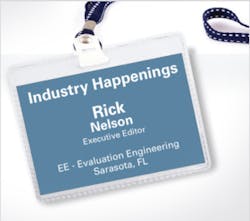NIWeek 2016 took place Aug. 1-5 in Austin, TX, with a reported 3,500 visitors. National Instruments was celebrating 40 years of NI and 30 years of LabVIEW, and Dr. James Truchard, co-founder and CEO, said the investment over the last 40 years paves the way for the next 40 years.
“We’ve worked determinedly to create the platform we now enjoy,” he said, which combines hardware and software into virtual instrumentation. The software approach, he said, allows you to preserve your investment while taking advantage of Moore’s law.
NI cofounder and business and technology fellow Jeff Kodosky said the hardware and software company has enjoyed finding innovative ways to bring technology to market, providing “… step-function advances in the tools used in our industry.” He said that 30 years ago he and coworkers were inspired by the Macintosh interface to develop LabVIEW; they ultimately created a version for the PC.
At the show, NI debuted LabVIEW 2016, which introduces new channel wires to simplify complex communication between parallel sections of code. Available on both desktop and real-time versions of LabVIEW, the channel-wire method helps improve code readability and reduces development time.
Chris Relf, chief architect at VI Engineering, said, “With channel wires, we can set up sophisticated software architectural patterns that natively have multiple sources without having to create and maintain considerable amounts of custom software in the background.”
In addition, NI introduced turnkey HIL simulators built on an open, modular architecture to help automotive and aerospace embedded-software testers maintain quality while handling the demands of shortened schedules, constantly changing test requirements, and reduced manpower. Anders Tunströmer, technical manager at Saab Aeronautics, said, “We chose an NI HIL test system because it is built on open, standard platforms that allowed us to reduce the overall cost of test.”
NI also announced the NI PXIe-6570 digital pattern instrument and NI Digital Pattern Editor. These products free manufacturers of RFICs, power management ICs, MEMS devices, and mixed-signal ICs from the closed architectures of conventional semiconductor ATE.
In addition, NI demonstrated an early-access technology platform for time-sensitive networking as part of its commitment to support the development of new standard technologies for synchronization and communications. NI said that in coordination with Cisco and Intel it is empowering customers to build distributed systems that perform synchronized I/O, code execution, and deterministic communication for distributed control and measurement loops, all using standard Ethernet.
NI also presented several applications for its new vector signal transceiver, including massive MIMO testing for 5G prototyping.
NI partners also rolled out new products. For example, Optimal+ debuted version 6.5 of its flagship software, which adds capabilities for electronics manufacturing test; Nvidia is using the new software to analyze the quality of its graphics boards.
Hewlett Packard Enterprise presented a high-performance edge-computing device with up to 64 cores; it can be located near a machine to analyze vibration and other parameters for predictive maintenance without the time and expense of sending the data to the cloud.
Averna introduced an automotive infotainment signal source based on NI’s vector signal transceiver. The software-defined AST-1000 can generate all common infotainment RF signals, including AM/FM, DAB, GPS, HD Radio, and Sirius/XM.
Astronics Test Systems highlighted a new rubidium/GPS frequency-standard test instrument. The new PXIe-3352 combines a rubidium oscillator with a GPS receiver in a single instrument. In development now, the PXIe-3352 is the second product developed from Astronics’ collaboration with NI with the goal of revitalizing legacy VXI-based test systems—the first being a PXI Express frequency-time-interval counter introduced at Autotestcon 2015.
Seica, in its debut appearance at NIWeek, demonstrated its new Pilot4D V8 HF, which combines flying-probe technology and high-frequency testing. The system can probe points associated with 008004 components while verifying signals up to 1.6 GHz. An integrated LabVIEW and TestStand software interface is optional.
And G Systems released a new valve leak measurement system (VLMS), a self-contained counting instrument for automating the industry-standard practice of leak detection by bubble formation using a submerged tube in water. The VLMS can be used for medical-device, pharmaceutical-equipment, oil, gas, and plumbing-valve applications.
Several customers and partners demonstrated applications during the daily keynote sessions. Applications extended from the Industrial Internet of Things to the Australian Murchison Widefield Array radio telescope.
Of particular note, a startup called Biostage generates organs for transplant from a patient’s stem cells. The company employed LabVIEW for rapid prototyping. “For this application, we enjoyed being able to use pre-existing toolkits and APIs for many system-level functions such as FTP and SQL database access, which allowed us to focus on the more application-specific challenges we needed to solve,” said Jeff Bouchard, manager of quality affairs.
You can view videos of NIWeek 2016 presentations at www.ni.com/niweek. NIWeek 2017 is moving up a few weeks on the calendar; it will be held May 22-25 in Austin.
Shortly after NIweek, NI announced that Dr. Turchard will be stepping down as CEO. The board of directors elected Alex Davern, 49, to serve as chief executive officer and president of National Instruments, effective Jan. 1, 2017. Dr. Truchard will remain as chairman of the board. The board of directors plans to appoint Davern to the board by the end of January 2017.
About the Author

Rick Nelson
Contributing Editor
Rick is currently Contributing Technical Editor. He was Executive Editor for EE in 2011-2018. Previously he served on several publications, including EDN and Vision Systems Design, and has received awards for signed editorials from the American Society of Business Publication Editors. He began as a design engineer at General Electric and Litton Industries and earned a BSEE degree from Penn State.
